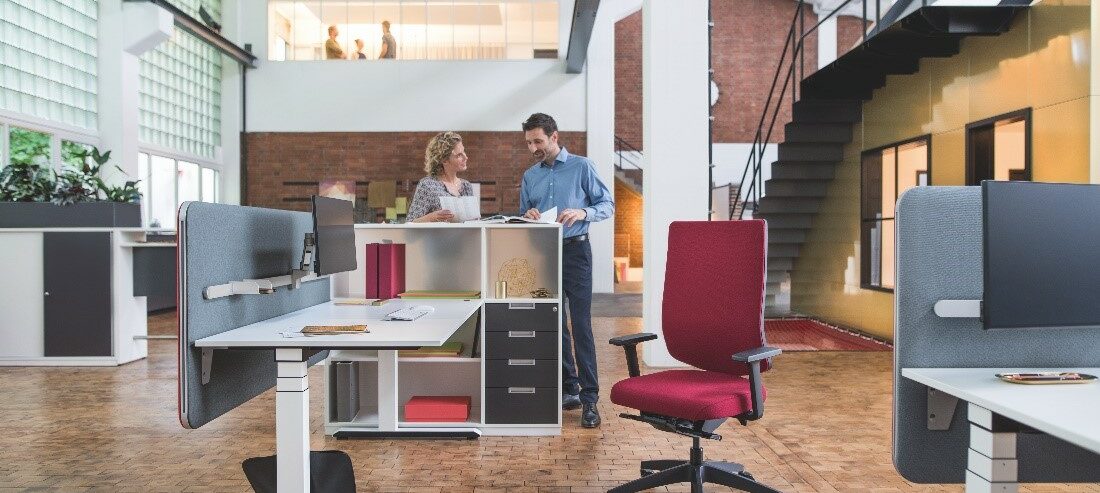Office Furniture: A Key to Workplace Productivity
Considering how often employees engage with it, office furniture is a vitally important part of a company’s assets. Most UK office workers (81%) spend four to nine hours each workday sitting at their desks. The same poll found that almost half of the employees surveyed (45%) said their employers didn’t offer the necessary tools and equipment to make them feel comfortable at their desks. It’s probably no coincidence that the same percentage said they didn’t think their employer cared about their health and wellbeing.
Office furniture can have a significant impact on the day-to-day and long-term wellbeing of office workers. This article will expand on why office furniture is such an important part of employee satisfaction.
How does office furniture affect employee productivity?
Professor Alex Haslam co-authored research on the psychology of office design at the University of Exeter. He says: “Not only does office design determine whether people’s backs ache, but it also has the potential to affect how much they accomplish, how much initiative they take, and their overall professional satisfaction … By paying more attention to employees’ needs, (employers) can boost wellbeing and productivity at a minimal cost.”
Office furniture affects physical comfort, mood, and, ultimately, how employees engage with each other and their work. When workers are comfortable and happy, they’re more productive.
How to improve productivity with the right office furniture
High-quality office furniture is more than just a workplace necessity. It’s the key to fostering an environment where people feel comfortable and empowered to do their job efficiently.
We’ve seen that a large percentage of workers are unhappy with the office furniture they are provided. Yet, the office furniture wholesaling industry expects revenue to rise £829.4 million for 2021-22. That’s a lot to spend for a disappointing result.
Businesses must consider the needs of workers, but then go farther. A company’s office space makes irrevocable first impressions on clients, competitors, job applicants and others. From reception desks to boardroom chairs and tables and even storage cabinets, office furniture sends a message about a business.
Fortunately, there is a huge range of options out there. Here are some strategic ways to improve productivity by choosing the right office furniture:
Choose ergonomic furniture
An ergonomic task chair design takes into consideration the different heights and body shapes of users. It also allows for adjustments to suit different heights and angles for them to work comfortably.
They also help to prevent back, neck, and shoulder problems that can stem from bad posture on an uncomfortable chair. A chair with poor support can cause reduced productivity. The worst-case scenario is employees needing to take time off to treat their ailments.
Choose adjustable furniture
A way to increase the value of adjustable chairs is to provide height-adjustable desks. This type of desk offers a great way for employees to find the best comfort level while working. It also helps to improve their posture. With a telescopic frame, employees can have the flexibility of scaling the desk up or down. They can even stand and work if they wish to!
Height-adjustable desks in the office can help employees increase blood flow, reduce lower back pain, burn calories, and improve posture. These are helpful ways to combat health issues like obesity, low mood and energy levels, heart disease, and back pain.
Consider color
Furniture (and walls) come in all different shades, colors, and textures. But did you know that color choice can have an impact on workplace productivity and mood? The impact of light and color on psychological mood in work environments was investigated in a large-scale international study. The presence of some colors, in comparison to a no-color or neutral-color condition, resulted in a more positive worker’s mood.
When choosing a color scheme for the office and its furniture, consider the atmosphere you’re trying to create. Also, consider what kind of work people will be doing in each area. Here are some of the emotions and moods that colors can help foster:
- Blue: Peace, tranquility
- Green: Growth, renewal
- Red: Vibrancy, energy
- Yellow: Optimism, innovation
Consider the workflow of the office
Office furniture will send a message about the office culture you are trying to represent and implement. At the same time it can boost your workers’ ability to do certain types of work. Do you want to create an “open office” feel with collaborative meeting spaces? Do you want to create a more divided space with private, quiet workspaces where employees can focus undisturbed? Choose what will be happening in each office space and how employees will (or will not) be engaging with each other.
Office furniture can enhance workers’ ability to function in 4 kinds of work situations — concentration, communication, cooperation, and contemplation.
These coordinate with specific demands on the working environments and on the furniture. For example, a workspace that is focused on cooperative work will have lots of open space. It will provide dynamic places for groups to meet. When the office furniture and flow are tailored to the needs of individuals, as well as the collective group, productivity is optimized, and positive workplace culture begins to thrive.
Choose the right office furniture for your space
When it comes to office furniture solutions, Sedus provides unmatched quality at competitive prices. Sedus offers a wide range of office furniture online, including office chairs, office desks, tables, storage space, filing cabinets, home office furniture, office accessories, and much more.
